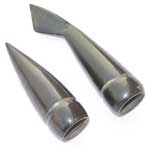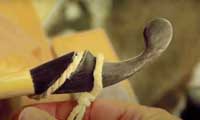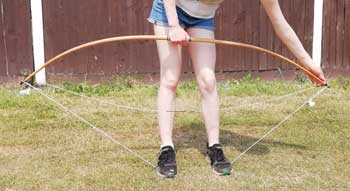


Information on shooting with a longbow is scattered all over the internet. This is an attempt to gather the information into one place.
World Archery has a section in the coaching manual. Longbow Section
There are many slightly different sets of rules for longbow shooting, AGB, WA, BLBS, ILAA, EFAA, IFAA, NFAS etc. So check the rules of a competition before you get there.
Archery GB Rules of Shooting 206 for longbow. The bow shall be not less than five feet in length for an arrow of less than 27 inches and; not less than five feet six inches in length for a 27” or longer arrow, this being measured along the back between the string nocks. At no point shall the depth of the bow, measured from back to belly, be less than 5/8 (five eighths) of the width of the bow at the same section. The bow may carry no support for the arrow.
Arrows shall have wooden steles (shafts), shall be fitted with feather fletchings, and may have either horn-reinforced, self or applied nocks. Unlike other bow types there is no maximum diameter. The pile shall not exceed the diameter of the shaft at the point of fitment.
For AGB field archery there are some more restrictions. The bow must be bare therefore marks on bow limbs and rubber bands are not allowed, neither is a “kisser” allowed on the string. Artificial ground markers are not allowed. Archers must adhere to one anchor point and to one finger-position on the string throughout a tournament.

| A longbow has different nocks at the top and bottom of the bow. The bottom nock is smaller and only has a single string groove. The top nock has two grooves, one for the string and a second, which may be shallow, for the stringer. The top nock is on the right in the first picture. The second picture shows a top nock with two similar grooves, the lower for the string and the upper for the stringer. Top nocks can also be carved into birds, horses heads, or dragons etc. The stringer goes on the neck of the animal, these carved nocks are expensive so you would not want to risk damaging them. | 
| 
|
 The safest method for the archer and bow is to use a stringer.
The stringer is a length of cord a little longer than the bow with loops on both ends.
For a bow with the shallow stringer groove, the top loop may be smaller,
so it cannot slide down into the string groove.
The safest method for the archer and bow is to use a stringer.
The stringer is a length of cord a little longer than the bow with loops on both ends.
For a bow with the shallow stringer groove, the top loop may be smaller,
so it cannot slide down into the string groove.
The string is put on top loop first and slid down the bow below the top nock. The bottom loop can then be put into the bottom string groove together with one of the stringer loops. The top stringer loop goes into the groove above the top string groove. Stand on the middle of the stringer and pull up on the bow handle enough to slide the top string loop into its groove. Unstring the bow the same way by sliding the top loop down the bow.

The bracing height, the distance from the string to the archers side of the handle, should be about 1/12 the length of the bow or about 5 1/2 to 6 inches. Depending on the size of your hand a fistmele is about 6 inches, make a fist and stick your thumb out. Adding or removing twists can change the bracing height by a small amount, bigger changes need a change to the string length which is easier with a single loop Flemish twist string and bowyers knot.

The string may have 0, 1 or 2 loops. Strings with 2 loops are the most common, and are used when the string length is known. If there is no bottom loop then a bowyers knot or timber hitch is used, which can easily be untied and re-tied to get the correct bracing height. This is most often used when making a bow and the string length is not known or changing. If there are no loops then a top loop can be tied using a bowline knot.
The string may be made of many different materials, check with your bows bowyer which is best. Brownell B50 Dacron is slightly stretchy so safe for most longbows, however it currently (2023) seems hard to get in the UK. (In 2019 Brownell assets were taken over by Badinotti Net Services Canada.) BCY B55 has similar properties to Dacron.
It may be either a continuous loop, like a recurve string or a Flemish twist string.
Flemish twist strings are made from 2 (or 3) bundles of strands, each bundle may be a different colour.
To make the bundles tapered ends it may help to have a flemish string jig,
a board with lots of pegs and peg holes and marked with the finished string length.
 Without a jig just cut bundles of stands of the string material about 20 inches (16 to 24) longer
than the required string length.
The ends of the strands are then staggered by about 1/2 inch to give a long taper at the end.
The string length is usually about 3 or 4 inches shorter than the distance between the bow nocks.
Without a jig just cut bundles of stands of the string material about 20 inches (16 to 24) longer
than the required string length.
The ends of the strands are then staggered by about 1/2 inch to give a long taper at the end.
The string length is usually about 3 or 4 inches shorter than the distance between the bow nocks.
Wax about 12 inches at the end of each bundle. Line up the ends of the bundles then put a clamp about 10 inches from the end. Hook the clamp over a fixed point (like a nail in the edge of the bench). The tricky part is the twisting of the ends. Starting at the clamp put a few twists into a bundle anticlockwise by rolling the bundle between thumb and finger. Then twist the bundles clockwise, using the other hand to stop it all untwisting. Doing the twists in opposite directions is key. Continue doing this for about 2 inches, or the size of the loop. Remove the clamp and merge the remaining ends with the bundle of the same colour to make the loop. Hook the loop over your fixed point, and do the twists as before all the way down the short ends. Trim off any strand ends that stick out.
Remove all twists from each bundle in the main part of the string. If your are making a second loop then put in about 20 more twists in the same direction as the untwists. These back twists should come out when the second end is twisted up leaving the main part of the string untwisted. Easier though is to make a 1 loop string and use a bowyers knot. Start twisting as before about 10 inches before the knot will be and when you get to the end tie a simple knot to stop it all coming untwisted. Twist the string before doing the center serving in the same direction as the end twists. None of this is easy, so you may have to practice a lot before you make a string you can actually use.
Richard Head - Making a Flemish twist bowstring Ron Harris - Making a Flemish twist bowstring
Take the end of your string and form a loop. Take the end of your string and lay it back over itself, passing it through the loop. Repeat for 3-4 times, and your knot is complete.
The center serving is the same for all bows so there are many videos online. Mick Grewcock - How to Centre Serve a Longbow String.
Using a bow square or bracing height gauge the top of the lower nock should be about ¼” above the top of the bow handle. Two nocking points are best, but some bows or archers only use the top nock. In this case the bottom of the nocked arrow needs to be about ¼” above the top of the bow handle.
This is so the arrow flies slightly nock high when leaving the bow and the feathers clear the hand. If the feathers clip the hand on loose then either move the hand down a little or the nocking point up.
Plastic arrow nocks can vary from ¼” up to 11/32”, larger diameter arrows (up to 1/2" for warbows) are usually bobtailed to make them easier to handle (the arrow tapers down to a smaller nock size).
Just above the bow handle there may be a horn insert which is to protect the bow from wear when shooting a large number of arrows.
Video: Richard Head Longbows - How to fit a nocking point
Longbows are not the most efficent bow, so are usually a heavier poundage than other bows. Warming up of the shoulders etc. is necessary to prevent injury.
Warming the bow is not usually necessary. In the days before good varnish and heating, bows were only waxed and may have be stored below freezing. There was a danger of moisture entering the bow. They would be warmed by the fire before shooting and rubbed with a waxed cloth between ends in bad weather.
One way of warming the shoulders is to pull the bow back a few inches without an arrow, and gradually increase up to full draw. AGB rules of shooting 102a, No archer may draw their bow, with or without an arrow, except when standing at the shooting line or peg.
Gap shooting is often the first aiming method taught when learning to shoot, and the main method in field archery were aiming aids are not permitted. In gap shooting, you look along the arrow and put the arrow point at a distance below or above above the center of the target. With target archery the target can be used as a measure. The "point on distance" is the distance at which aiming at the center hits the center.
With this we add a thin elastic band to the upper limb to act as a bow sight, it needs to be less than 1/8" in diameter to meet the AGB rules. Use the mediteranean draw (one finger above the arrow and two under) below the chin to get the maximum range. Use a small ruler to make notes of the position for each distance, as marks than can be seen when drawing the bow are not allowed.
This method allows aiming at the gold, and can be adjusted during an end.
A ground marker is basically an object (6x3 inches max) that you place on the range at the start of the round that you use as a reference for your arrow point. Again, use the mediteranean draw below the chin to get the maximum range.
With this you are aiming at the ground, and can only adjust the marker between ends.
Target archery: shooting dozens of arrows at a 4ft diameter target which may be up to 100 yards away for men, shorter distances for women and juniors. An archer may have one bow and arrows for the longest distance, and another lighter bow and arrows for the shorter distances.
Field archery: shooting a few arrows at different targets, usually on uneven ground and possibly with trees.
Clout archery: shooting (usually 3 dozen arrows) at a marker post which may be up to 180 yards away for men, getting as close as possible to score points.
Popinjay: shooting almost straight up at bird targets.
Flight archery: shooting arrows as far as possible. Classes for different bow weights, and arrows are usually specially designed and made.
Three main parts to the arrow to select and get right, are pile or arrow head, shaft and feather fletchings. Traditionally only left wing feathers were used, as mixing left and right wing feathers produces a bad arrow. The nock is also needed but not usually difficult to select unless doing flight archery.
For short distances, indoor or field archery, large feathers of 4 inches or more will stabilize the arrow quickly but have more drag and slow the arrow down. The pile can be 125 grains, which will also stabilize the arrow faster, but slow the arrow down by the increased mass. The spine of the shaft needs to be slightly stiffer to support the weight of the pile. Field archery piles have a reduced diameter before the point so they are less likely to bounce off the target.
For clout or target archery, smaller and lower feathers of 2 1/2 or 3 inches are better, less drag and slightly slower to stabilize. The pile can be 60 to 80 grains, with a shaft selected to match, which saves weight and makes a faster arrow. Target archery piles are usually bullet shaped.
For flight archery, where distance is important and there is no target to hit, very tiny feathers and a very light point are best. The shaft and nock need to be aerodynamic.
Most shaft makers or sellers have a table of bow weight and arrow length to select the best spine. However, they don't always give the point weight. The old AMO/ATA system for wooden arrows is based on a bow that is 1/8" out from centre shot. The arrow would be 28" long and have a 125 grain point.
The Eastom/ASTM spine is measured at 28" with a 1.94lb (880 gram) weight. The AMO spine is measured at 26" with a 2lb weight. AMO = ASTM x 0.8254. The bow weight for that arrow is then 26 / AMO spine.
The spine of wooden arrow shafts are usually selected into a 5lb range, eg. 30-35 lbs. For longbows which are not centre shot you need to use an arrow which is 5 to 10lbs lighter so the arrow can bend around bow. The bending of the arrow on release depends on how the string comes off the archers fingers, making it slightly different for each archer. For each 25 grain change in pile weight or 1 inch change in length add or subtract 5lbs to the spine. eg. for a 100 grain pile substract 5 lbs from the arrow spine for the same bow, for a 26 inch arrow subtract 10 lbs. For a 42lb bow with 27 inch arrows and 100 grain piles, may need 42 - 5 - 5 = 30-35lb spine shafts. This only works for a small range of changes and the error is usually covered by the 5lb range of spines. So this is all only rough so try before your buy if possible, otherwise its easier to start with a longer shaft and cut them if they are weak.For a right handed archer, if the arrows go left of where they are aimed, then the arrows are too stiff. If they go to the right then they are too weak. Arrows can be stiffened by making then shorter, or by using lighter piles. They can be weakened by using heavier piles or by buying longer arrows of the same spine.
All this mainly shows up with bareshafts, once the arrows are fletched they tend to go a lot straighter. So having slightly the wrong spine may just affect the group size.
Shafts from 1/4" to 1/2" are available, with 5/16" and 11/32" being most common. Plastic nocks need an 11° taper and to be accuratly centered. Points are 5° taper, parallel or screw on.
Carol Archery for parts. Probably the only place for 1/4" shafts and she can machine the ends for parallel points.
John Potter's book "Making Wooden Arrows, A Master's Guide"
John Marshall's presentation "Wooden Arrow Workshop"
Bow International - Making and tuning wooden arrows
Feather cutting templates. Shield and parabolic feathers in 3 inch and above are easy to obtain, Heritage Longbows have acrylic templates for smaller fletchings and many other shapes. You need a small rotary cutter and cutting mat as well.
Heritage Longbows do a course to make a bow or arrows. They also sell parts.
Richard Head - How to make a Longbow
Toxophilus. Roger Ascham, 1545.
Archery: It's Theory and Practice. Horace Ford, 1859
The Longbow. Mike Loades, 2013